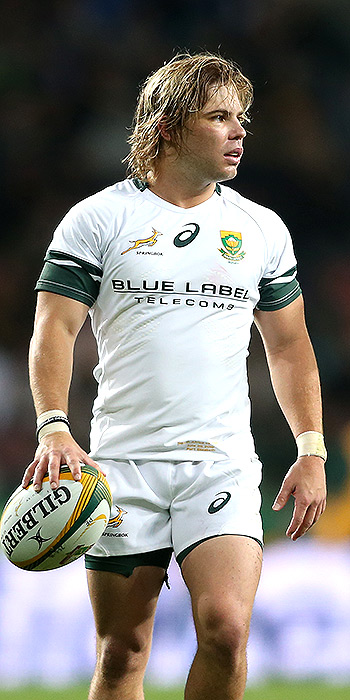Law discussion: Faf's five metres
Ireland are penalised at a collapsed scrum in the Test in Port Elizabeth at the weekend.
Warren Whiteley, the South Africa No.8, throws the ball to Francois de Klerk, the South African scrumhalf, who takes a tap kick and races ahead. Iain Henderson of Ireland grabs at De Klerk, and the ball falls free. Henderson picks it up and Ireland attack down the left with a telling break by Luke Marshall whose pass to unmarked Keith Earls goes astray.
Have a close look at the incident (see clip below) which occurred after 35 minutes in the match and then try the little quiz below.
1. Did De Klerk take the tap kick from the right place?
2. Was Henderson back 10 metres when he played De Klerk?
3. Had De Klerk run five metres when Henderson played him?
4. Did Henderson lose the ball forward in his contact with De Klerk?
1. Law 21.1 WHERE PENALTY AND FREE KICKS ARE AWARDED
Unless a Law states otherwise, the mark for a penalty or free kick is at the place of infringement.
Law 21.2 WHERE PENALTY AND FREE KICKS ARE TAKEN
(a) The kicker must take the penalty or free kick at the mark or anywhere behind it on a line through the mark.
(c) If a quickly taken penalty kick or free kick is taken from the wrong place the referee will order the kick to be taken again.
 Where did the infringement take place?
Where did the infringement take place?
It was in the scrum. That's where the mark was. The place where the penalty kick was to be taken was at the mark (i.e. in the scrum) or behind it.
Where was the kick taken?
Well to the right of the scrum.
The referee would have been right to have the kick taken again and from the right place.
Nitpicking? Not at all. De Klerk gained additional freedom to run because of the place where he took the kick. A penalty does not give the non-offending team the right to take the kick wherever it suits them.
That makes the other three questions redundant but let's answer them as well as they are interesting.
2. The first point is – back to metres from what?
Law 21.7 WHAT THE OPPOSING TEAM MUST DO AT A PENALTY KICK
(a) Must run from the mark. The opposing team must immediately run towards their own goal-line until they are at least 10 metres away from the mark for the penalty kick, or until they have reached their goal-line if that is nearer the mark.
Not from where De Klerk tapped the ball, which was behind the fallen South Africa scrum but 10 metres back from where the infringement was in that tangled heap of players. Henderson was a lock, part of the infringing scrum. He was certainly not back 10 metres from the mark. that means he was not entitled to play De Klerk.
3. This was a claim made by the panel of ex-internationals in discussion of the match after the match in justification of what Henderson did.
The running five metres is part of being offside and put onside by the action of an opponent. It is an entirely irrelevant answer. This is not an offside situation.
Offside occurs at a scrum, line-out, ruck or maul or by being in front of a player of your own side who last played the ball. A tap kick is not a scrum, line-out, ruck or maul and a tap by a South Africa does not put an Irishman offside.
This just is not a case of offside at all. That De Klerk may have run five metres is irrelevant. Please, say that loudly to yourself.
Law 21.7 goes on and makes it clear that Henderson was not in the clear.
Law 21.7 WHAT THE OPPOSING TEAM MUST DO AT A PENALTY KICK
(b) Must keep running. Even if the penalty kick is taken and the kicker’s team is playing the ball, opposing players must keep running until they have retired the necessary distance.
They must not take part in the game until they have done so.
(c) Kick taken quickly. If the penalty kick is taken so quickly that opponents have no opportunity to retire, they will not be penalised for this. However, they must continue to retire as described in 21.7 (b) above or until a teammate who was 10 metres from the mark has run in front of them, before they take part in the game.
Sanction: Any infringement by the opposing team results in a second free kick, awarded 10 metres in front of the mark for the first kick. This mark must not be within 5 metres of the goal-line. Any player may take the kick. If the referee awards a second free kick, the second free kick is not taken before the referee has made the mark indicating the place of the free kick.
That's clear enough.
4. Does De Klerk lose the ball or Henderson rip the ball from him?
If De Klerk lost the ball backwards, play could – making allowance for all the other things that went wrong – go on and Henderson was allowed to play the ball.
If Henderson ripped the ball from De Klerk's grasp, it then went forward from Henderson's action and should be treated as a knock-on, i.e. a scrum ordered to South Africa.
It was not a carefully refereed bit of play and the whole five-metre debate was ridiculous.
By Paul Dobson
@rugby365com















































